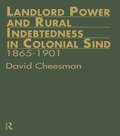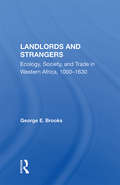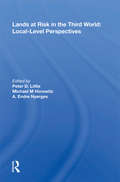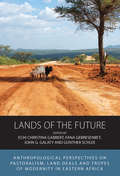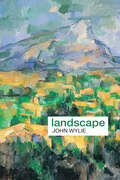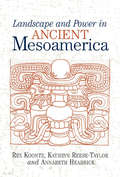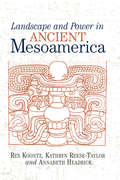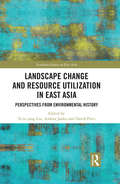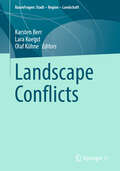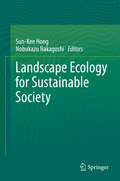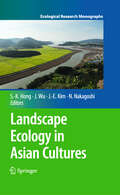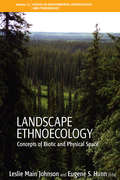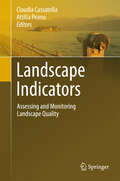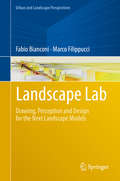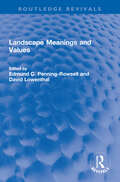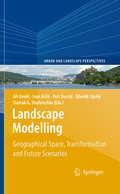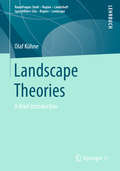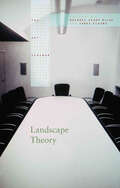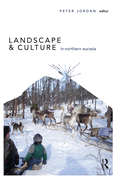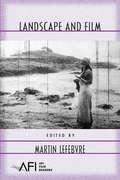- Table View
- List View
Landlord Power and Rural Indebtedness in Colonial Sind
by David CheesmanInvestigates the alliance between the British administration and the Muslim landed magnates who dominated the countryside and provides valuable insights into the emergence of the elite's governing Pakistan today.
Landlord and Tenant: Housing the Poor in Urban Mexico
by Alan Gilbert Ann VarleyThis ground-breaking work employs survey data and in-depth interviews to compile a detailed picture of landlords and tenants in developing countries. Focusing on Mexico the authors examine the state's housing policy, with its clear bias towards increasing home ownership, and explores the possibilities of improving the quality and increasing the stock of rented accommodation in the developing World.
Landlords And Strangers: Ecology, Society, And Trade In Western Africa, 1000-1630
by George E BrooksParticipants included scholars, government officials, and journalists from European and American countries ranging from Finland to Argentina. This volume contains the papers presented. The viewpoints represent those who favor a negotiated settlement through the Contadora process, those who espouse the policies of the Reagan administration, and thos
Lands At Risk In The Third World: Local-level Perspectives
by Peter D. LittleThis book presents case studies highlighting social, economic, political, and biological dimensions of environmental degradation in the Third World. It uses local data to examine, test, and refine larger explanatory models and theories. .
Lands of the Future: Anthropological Perspectives on Pastoralism, Land Deals and Tropes of Modernity in Eastern Africa (Integration and Conflict Studies #23)
by Günther Schlee Echi Christina Gabbert, Fana Gebresenbet, John G. GalatyRangeland, forests and riverine landscapes of pastoral communities in Eastern Africa are increasingly under threat. Abetted by states who think that outsiders can better use the lands than the people who have lived there for centuries, outside commercial interests have displaced indigenous dwellers from pastoral territories. This volume presents case studies from Eastern Africa, based on long-term field research, that vividly illustrate the struggles and strategies of those who face dispossession and also discredit ideological false modernist tropes like ‘backwardness’ and ‘primitiveness’.
Lands of the Future: Anthropological Perspectives on Pastoralism, Land Deals and Tropes of Modernity in Eastern Africa (Integration and Conflict Studies #23)
by Günther Schlee Echi Christina Gabbert, Fana Gebresenbet, John G. GalatyRangeland, forests and riverine landscapes of pastoral communities in Eastern Africa are increasingly under threat. Abetted by states who think that outsiders can better use the lands than the people who have lived there for centuries, outside commercial interests have displaced indigenous dwellers from pastoral territories. This volume presents case studies from Eastern Africa, based on long-term field research, that vividly illustrate the struggles and strategies of those who face dispossession and also discredit ideological false modernist tropes like ‘backwardness’ and ‘primitiveness’.
Landscape (Key Ideas in Geography)
by John WylieLandscape is a stimulating introduction to and contemporary understanding of one of the most important concepts within human geography. A series of different influential readings of landscape are debated and explored, and, for the first time, distinctive traditions of landscape writing are brought together and examined as a whole, in a forward-looking critical review of work by cultural geographers and others within the last twenty to thirty years. This book clearly and concisely explores ‘landscape’ theories and writings, allowing students of geography, environmental studies and cultural studies to fully comprehend this vast and complex topic. To aid the student, vignettes are used to highlight key writers, papers and texts. Annotated further reading and student exercises are also included. For researchers and lecturers, Landscape presents a forward-looking synthesis of hitherto disparate fields of inquiry, one which offers a platform for future research and writing.
Landscape And Power In Ancient Mesoamerica
by Annabeth Headrick Kathryn Reese-Taylor Rex KoontzFrom the early cities in the second millennium BC to the Aztec capital of Tenochtitlan on the eve of the Spanish conquest, Ancient Mesoamericans created landscapes full of meaning and power in the center of their urban spaces. The sixteenth century description of Tenochtitlan by Bernal Diaz del Castillo and the archaeological remnants of Teotihuacan attest to the power and centrality of these urban configurations in Ancient Mesoamerican history. In "Landscape and Power in Ancient Mesoamerica," Rex Koontz, Kathryn Reese-Taylor, and Annabeth Headrick explore the cultural logic that structured and generated these centers. Through case studies of specific urban spaces and their meanings, the authors examine the general principles by which the Ancient Mesoamericans created meaningful urban space. In a profoundly interdisciplinary exchange involving both archaeologists and art historians, this volume connects the symbolism of those landscapes, the performances that activated this symbolism, and the cultural poetics of these ensembles.
Landscape And Power In Ancient Mesoamerica
by Annabeth Headrick Kathryn Reese-Taylor Rex KoontzFrom the early cities in the second millennium BC to the Aztec capital of Tenochtitlan on the eve of the Spanish conquest, Ancient Mesoamericans created landscapes full of meaning and power in the center of their urban spaces. The sixteenth century description of Tenochtitlan by Bernal Diaz del Castillo and the archaeological remnants of Teotihuacan attest to the power and centrality of these urban configurations in Ancient Mesoamerican history. In Landscape and Power in Ancient Mesoamerica, Rex Koontz, Kathryn Reese-Taylor, and Annabeth Headrick explore the cultural logic that structured and generated these centers.Through case studies of specific urban spaces and their meanings, the authors examine the general principles by which the Ancient Mesoamericans created meaningful urban space. In a profoundly interdisciplinary exchange involving both archaeologists and art historians, this volume connects the symbolism of those landscapes, the performances that activated this symbolism, and the cultural poetics of these ensembles.
Landscape And Power In Ancient Mesoamerica
by Rex KoontzFrom the early cities in the second millennium BC to the Aztec capital of Tenochtitlan on the eve of the Spanish conquest, Ancient Mesoamericans created landscapes full of meaning and power in the center of their urban spaces. The sixteenth century description of Tenochtitlan by Bernal Diaz del Castillo and the archaeological remnants of Teotihuacan attest to the power and centrality of these urban configurations in Ancient Mesoamerican history. In Landscape and Power in Ancient Mesoamerica, Rex Koontz, Kathryn Reese-Taylor, and Annabeth Headrick explore the cultural logic that structured and generated these centers.Through case studies of specific urban spaces and their meanings, the authors examine the general principles by which the Ancient Mesoamericans created meaningful urban space. In a profoundly interdisciplinary exchange involving both archaeologists and art historians, this volume connects the symbolism of those landscapes, the performances that activated this symbolism, and the cultural poetics of these ensembles.
Landscape Change and Resource Utilization in East Asia: Perspectives from Environmental History (Academia Sinica on East Asia)
by Ts'Ui-Jung Liu Andrea Janku David PietzCovering the ancient period through to the 21st century, this book examines how landscapes have changed across East Asia over time. Featuring examples of a variety of landscapes, from the riverine and agricultural to the urban and aesthetic, this books thus presents a comprehensive review of East Asian environmental history. <P><P>The eleven chapters, written by an international team of leading scholars, provide analysis of a wide range of spatial, temporal, and thematic considerations. Seeking to use the concept of landscape to evaluate the opportunities and constraints faced by East Asian communities, it also explores the relationship between landscape transformation and human agency. In so doing, it aims to survey the current methodology and scholarship in the field and demonstrate a new approach which encompasses socio-economic and cultural history, as well as GIS-based geographical studies. <P><P>Providing an in-depth examination of landscape change across the sub-regions of China and Japan, this book will be useful to students and scholars of Asian History and Environmental Studies.
Landscape Conflicts (RaumFragen: Stadt – Region – Landschaft)
by Olaf Kühne Karsten Berr Lara KoegstLandscape conflicts, for example in connection with / in view of the energy transition, climate policy, transport policy, nature conservation, the extraction of mineral raw materials, the design of urban landscapes or tourism are potentially associated with high economic, social and political costs even before a possible escalation. It is therefore undoubtedly useful to gain a better understanding of landscape-related conflicts in terms of their causes, their course, their dynamics, their inherent logic and possible regulatory procedures. Frequently, such conflicts manifest themselves in particular in different claims and aspired or arrogated interpretative sovereignties concerning what can or may be considered together as 'landscape' (here understood as a special case to 'space'), and these conflicts are not limited to the economic dimension, but they also ignite in social, political and cultural, often also in aesthetic and moral questions. The contributions to this anthology therefore focus on the question of how landscape conflicts can be seen as a productive social normality and be brought to a non-violent and not necessarily consensual settlement.
Landscape Ecology for Sustainable Society
by Sun-Kee Hong Nobukazu NakagoshiThe research category of the landscape ecology, which researches the structure, functions, and the spatio-temporal changes of the ecological landscapes, has now been contributing to the human life and the shifts of the socio-economic paradigm. Global warming has been influencing the universal life patterns of the mankind which have been maintained in the past several hundreds of years. And it has been having the influences on the international social problems and economic problems. Although the diverse plans for adapting to the climate changes have been the topics of the conservations among the ecologists internationally, it is the reality that the speed of the changes of the environment has been quicker than the time it takes to complete the solutions. In order to maintain the sustainable earth and the sustainable society, the role of the landscape ecology has been coming to the fore. Especially, the theories and the methodologies of the landscape ecology have been applied to the multidisciplinary researches by going beyond the research category of ecology, including the maximization of the efficiencies of the land spaces, the management of the ecological space (habitats) in which the biological diversity can be maintained, the utilization of the resources that are absolutely needed by the human beings (Here, it is compressed to water, energy, and food), etc. and until reaching the human society. It is considered that, to that extent, the utilizations and the applications of the landscape ecology are very much needed for the diagnoses and the evaluations of the global environmental problems which have been proceeded with rapidly in the modernity.This book is not comprised of any general remarks that explain the theories and the methods of the landscape ecology. Already, based on the basic theories of the landscape ecology, the writers have conducted the investigations on the farm villages, the cities, and the coastal ecosystems. And, through the space analyses and interpretations, the structure and functions of the landscapes were analyzed. Of course, in this book, too, the diverse ecosystems and the landscape ecological methodologies regarding the land use have been presented. However, the core of this book focuses more on what role the landscape ecology must play for the materialization of a sustainable society in the future. At the farm villages, the sustainable agriculture will be presented, and, at the cities, the discussions on the green networks and the energies will be proceeded with. Also, regarding the coasts and the seas, a thesis on the safety of the life zones of the residents adjacent to the sea and on the conservation of the island ecosystems will be presented. The sustainable society is a system that is formed by having the sustainable development as a basis. It is considered to be one aspect within a kind of a sustainable process with regard to which the natural world and the human world coexist and are in a symbiotic relationship harmoniously. In order to maintain the biodiversity, the reasonable adjustments of the human activities, like the use of the resources, are absolutely needed. Without the biological resources, the cultural diversity of the human beings, too, cannot exist. Consequentially, recently and internationally, there are a lot of the case examples that express the biocultural diversity by linking the biological diversity with the cultural diversity. In this book, the role of the landscape ecology as an academic link which can connect the two possible, if possible, is highly expected. It is, indeed, the biocultural landscape. It can be said that this concept, also, is the interconnection of the multidisciplinary spaces that must be dealt with in the modern landscape ecology. Through this book, it is intended to present a new directionality which can contribute to the sustainable society at the same time as the organization of the theories and the methods of the landscape ecology.
Landscape Ecology in Asian Cultures
by Sun-Kee Hong Jianguo Wu Jae-Eun Kim Nobukazu NakagoshiCultural landscapes are a product of the interactions between humans and natural settings. They are landscapes and seascapes that are shaped by human history and land use. Socioeconomic processes especially, but also environmental changes and natural disturbances, are some of the forces that make up landscape dynamics. To understand and manage such complex landscapes, interdisciplinary and transdisciplinary approaches are necessary, emphasizing the integration of natural and social sciences and considering multiple landscape functions. The spatial patterns of Asian landscapes are strongly related to human activities and their impacts. Anthropogenic patterns and processes have created numerous traditional cultural landscapes throughout the region, and understanding them requires indigenous knowledge. Cultural landscape ecology from a uniquely Asian perspective is explored in this book, as are the management of landscapes and land-use policies. Human-dominated landscapes with long traditions, such as those described herein, provide useful information for all ecologists, not only in Asia, to better understand the human-environmental relationship and landscape sustainability.
Landscape Ethnoecology
by Leslie Main Johnson Eugene S. HunnAlthough anthropologists and cultural geographers have explored "place" in various senses, little cross-cultural examination of "kinds of place," or ecotopes, has been presented from an ethno-ecological perspective. In this volume, indigenous and local understandings of landscape are investigated in order to better understand how human communities relate to their terrestrial and aquatic resources. The contributors go beyond the traditional ecological knowledge (TEK) literature and offer valuable insights on ecology and on land and resources management, emphasizing the perception of landscape above the level of species and their folk classification. Focusing on the ways traditional people perceive and manage land and biotic resources within diverse regional and cultural settings, the contributors address theoretical issues and present case studies from North America, Mexico, Amazonia, tropical Asia, Africa and Europe.
Landscape Indicators
by Claudia Cassatella Attilia PeanoIn recent years EU policy towards the 'landscape' has become better defined, whereas at the same time the notion of 'landscape' itself remains elusive. The need for indicators to evaluate and monitor the effects of landscape policies and plans is urgent. What is more, landscape is one of the components considered in environmental reporting, but unlike air, soil, or water, it is difficult to measure using quantitative methods. With studies on landscape indicators being as rare as they are, this volume is an attempt to fill the gap, dealing as it does with the definition and use of specific indicators for landscape assessment and monitoring. To tackle the diverse dimensions of the landscape (whose complexity is well known), the subject is approached by a multidisciplinary team of experts in landscape ecology, landscape history, landscape perception, regional planning, strategic environmental assessment and environmental impact assessment procedures, and multi-criteria assessment methods. Individual chapters include comparative assessments of studies conducted thus far in the EU, as well as detailed analyses of ecological, historical, perceptive, land-use, and economic ways of looking at landscape. As well as providing a rich source of references for researchers studying the landscape from a variety of perspectives, the book will be required reading for European officials involved at any level in planning or assessing the landscape or environment.
Landscape Indicators: Assessing and Monitoring Landscape Quality
by Claudia Cassatella Attilia PeanoIn recent years EU policy towards the ‘landscape’ has become better defined, whereas at the same time the notion of ‘landscape’ itself remains elusive. The need for indicators to evaluate and monitor the effects of landscape policies and plans is urgent. What is more, landscape is one of the components considered in environmental reporting, but unlike air, soil, or water, it is difficult to measure using quantitative methods.With studies on landscape indicators being as rare as they are, this volume is an attempt to fill the gap, dealing as it does with the definition and use of specific indicators for landscape assessment and monitoring. To tackle the diverse dimensions of the landscape (whose complexity is well known), the subject is approached by a multidisciplinary team of experts in landscape ecology, landscape history, landscape perception, regional planning, strategic environmental assessment and environmental impact assessment procedures, and multi-criteria assessment methods. Individual chapters include comparative assessments of studies conducted thus far in the EU, as well as detailed analyses of ecological, historical, perceptive, land-use, and economic ways of looking at landscape.As well as providing a rich source of references for researchers studying the landscape from a variety of perspectives, the book will be required reading for European officials involved at any level in planning or assessing the landscape or environment.
Landscape Lab: Drawing, Perception and Design for the Next Landscape Models (Urban and Landscape Perspectives #20)
by Fabio Bianconi Marco FilippucciThis book explores the relationship between the sciences of representation and the strategy of landscape valorisation. The topic is connected to the theme of the image of the city, which is extended to the territory scale and applied to case studies in Italy’s Umbria region, where the goal is to strike a dynamic balance between cultural heritage and nature. The studies demonstrate how landscape represents an interpretive process of finding meaning, a product of the relationships between mankind and the places in which it lives. The work proceeds from the assumption that it is possible to describe these connections between environment, territory and landscape by applying the Vitruvian triad, composed of Firmitas (solidity), Utilitas (utility) and Venustas(beauty). The environment, the sum of the conditions that influence all life, represents the place’s solidity, because it guarantees its survival. In turn, territory is connected to utility, and through its etymological meaning is linked to possession, to a domain; while landscape, as an “area perceived by people”, expresses the search for beauty in a given place, the process of critically interpreting a vision.
Landscape Meanings and Values (Routledge Revivals)
by Edmund C. Penning-Rowsell; David LowenthalFirst published in 1986, Landscape Meanings and Values presents a major contribution to the debate concerning the relationship between theory and practice in landscape analysis and planning. It brings together a number of the most eminent researchers, commentators and practitioners from both the United States of America and Britain to pursue the fundamental meanings and values in landscape. The insights into the theory behind landscape management will force a fundamental rethink of the role of landscape architect and land management. Academic researchers will find the feedback from eminent practitioners a stimulation for more practical research. The collection of ideas in the last chapter provides a unique synthesis of the need for an expansion of study into the fundamental significance of landscape today. This book will be of value to students of geography, environmental studies, landscape architecture and land management.
Landscape Modelling
by Siamak G. Shahneshin Ivan Bičík Jiří Anděl Petr Dostál Zdeněk LipskýLandscape modelling integrates the differing perspectives of the many disciplines that deal with the landscape. It is motivated not only by the desire for scientific understanding, but also by the real-time demands of 21st century postindustrial society, which include the twin imperatives of stabilizing damaged ecosystems on the one hand, and finding effective ways to use the landscape on the other. The discipline has the specific goal of designing and assessing future scenarios of landscape development, while not losing sight of its past history, both ecological and socio-cultural. This book encompasses the interrelated disciplines of geography, landscape ecology and geoinformatics, and by drawing on their theories and methodologies introduces the concept of a living landscape with human action an inseparable part of its evolution. It offers researchers and decision-makers a number of ideas on how our landscape can best be utilized. The content reflects the need for sustainable landscape development, at the same time as considering long-term continuity as a major condition which enables us to maintain the diversity and multifunctionality of landscapes at regional and macro-regional scales. Employing advanced terminology and methods, this book provides specific results especially for scientists and landscape professionals.
Landscape Planning at the Local Level
by Luigi La RicciaThe book, showing virtuous examples of urban planning in Italy and Europe, exposes certain doubts and open questions: what is the new role of urban planning? What actions / rules are now achievable for the protection, planning and management of local-scale landscapes? The overall reflections gathered in the book contribute to suggest innovative visions about landscape planning at local scale, seen as first steps towards a more functional change of perspective. New landscapes are the result of local planning practices that no longer seem able to "understand" the current society through urban design. Public space and new urban centralities interact with the increasingly complex functions of social life and mark the distance from territorial values, relying less and less on physical relationships (economic and functional) and increasingly on symbolic and intangible relationships, as 'cultural identity'. Landscape is essential for the sustainable future of the urban and rural territory: the landscape quality is a factor of economic competitiveness and acts also as a factor of social cohesion and integration.
Landscape Theories: A Brief Introduction (RaumFragen: Stadt – Region – Landschaft)
by Olaf KühneIn the past decades, the discussion about theoretical approaches to the topic of 'landscape' has increased. This book presents the currently discussed theoretical approaches to landscape and shows its potentials and limits. The theoretical approaches are discussed on the basis of current questions, such as socialisation and the hybridisation of landscape, and combined with empirical results. This is followed by a discussion of the landscape policy operationalisation of theoretical considerations and empirical findings.
Landscape Theory (The Art Seminar)
by James Elkins Rachael Ziady DeLUEArtistic representations of landscape are studied widely in areas ranging from art history to geography to sociology, yet there has been little consensus about how to understand the relationship between landscape and art. This book brings together more than fifty scholars from these multiple disciplines to establish new ways of thinking about landscape in art.
Landscape and Culture in Northern Eurasia (UCL Institute of Archaeology Publications #54)
by Peter JordanThis unique volume aims to break down the lingering linguistic boundaries that continue to divide up the circumpolar world, to move beyond ethnographic ‘thick description’ to integrate the study of northern Eurasian hunting and herding societies more effectively by encouraging increased international collaboration between archaeologists, ethnographers and historians, and to open new directions for archaeological investigation of spirituality and northern landscape traditions. Authors examine the life-ways and beliefs of the indigenous peoples of northern Eurasia; chapters contribute ethnographic, ethnohistoric and archaeological case-studies stretching from Fennoscandia, through Siberia, and into Chukotka and the Russian Far East.
Landscape and Film (AFI Film Readers)
by Martin LefebvreFirst published in 2006. Routledge is an imprint of Taylor & Francis, an informa company.
